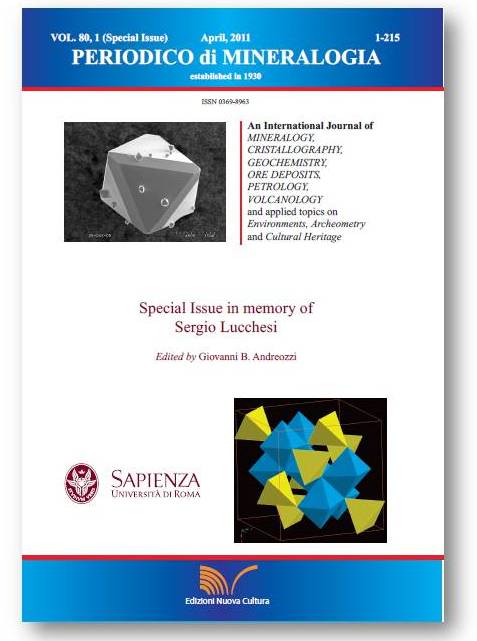Magnetic properties and cation ordering in two synthetic bornite samples, Cu<sub>5</sub>(Fe, Mn)S<sub>4</sub>
DOI:
https://doi.org/10.2451/2011PM0009Keywords:
bornite, intervalence charge transfer, EPR spectroscopy, SQUID magnetometry, EPMA, Mn(II)Abstract
Periodico di Mineralogia (2011), 80, 1 (Special Issue), 113-121 - DOI: 10.2451/2011PM0009
Special Issue in memory of Sergio Lucchesi
Magnetic properties and cation ordering in two synthetic bornite samples, Cu5(Fe, Mn)S4
Miria Borgheresi1, Francesco Di Benedetto2,*, Andrea Caneschi2, Maurizio Romanelli2 and David J.Vaughan3
1Via Matteotti 27, Pontassieve, Firenze, Italy
2Dipartimento di Chimica, Università di Firenze, Sesto Fiorentino, Firenze, Italy
3Williamson Research Centre for Molecular Environmental Science, and School of Earth, Atmospheric and Environmental Sciences, University of Manchester, UK
*Corresponding author: francesco.dibenedetto@unifi.it
Abstract
The magnetic properties of a synthetic bornite, Cu5FeS4, and of a Mn-bearing synthetic bornite were investigated using Superconducting Quantum Interference Device (SQUID) magnetometry and room temperature X-band Electron Paramagnetic Resonance (EPR) spectroscopy. Samples were synthesised from the elements using conventional dry methods. Chemical and phase compositions of the samples were confirmed by means of Electron Probe Micro-Analysis (EPMA) and by powder X-Ray Diffraction (XRD).
Experimental results, interpreted using spectral simulations, highlight the superexchange nature of ionic interactions between paramagnetic centres and the role played by partial intervalence charge transfer between the Fe(III) and Cu(I) species in natural and synthetic bornite. The cation distribution in synthetic samples was shown to be different from the natural sample, in spite of the close similarity in chemical composition and structure.
Key words: bornite; intervalence charge transfer; EPR spectroscopy; SQUID magnetometry; EPMA; Mn(II).


